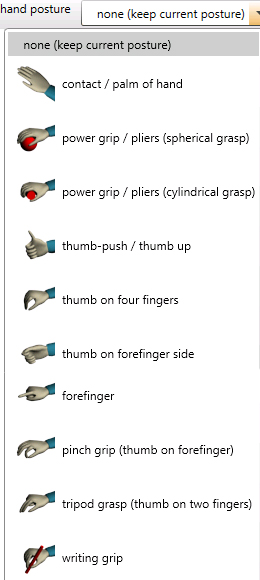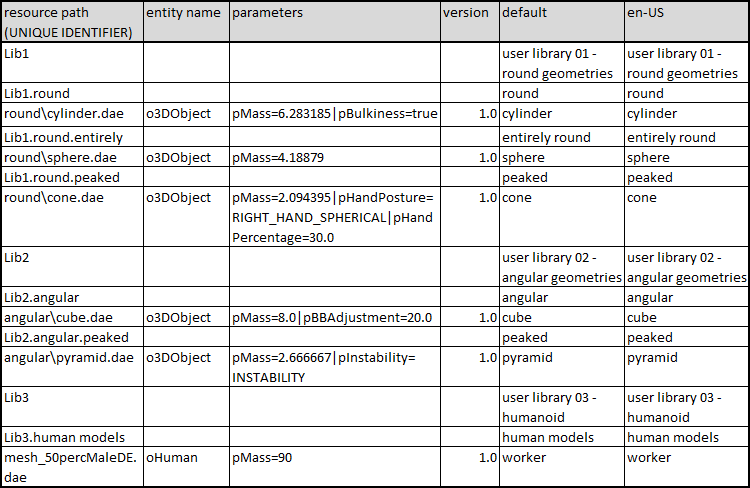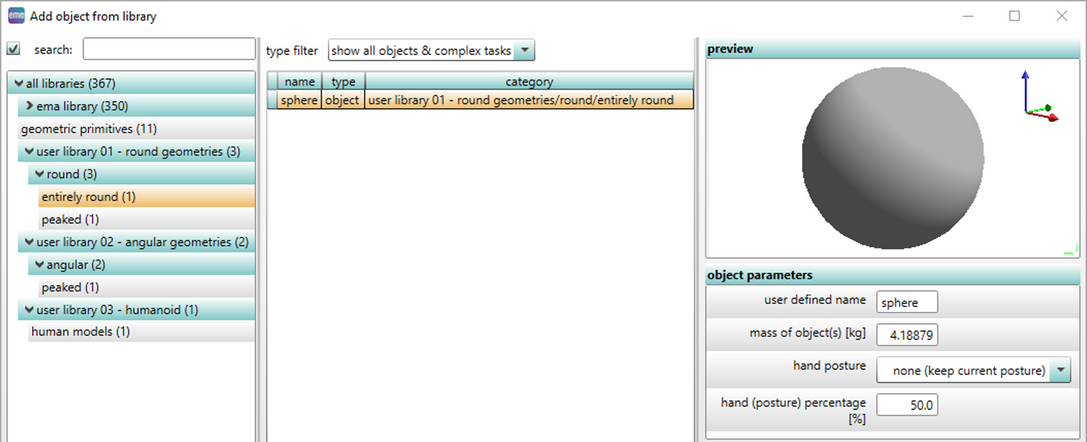In order to create a custom resource library, follow these steps:
1)Create a folder and name as desired.
2)Copy object files (for supported file formats see Mode of operation / File types), into this folder. Folder management within the parent folder is possible.
3)Create a csv file in this folder, using the illustration below as a guide (see figure Example structure of a csv file). Select the folder created in Step 1 using the Create content file for resource library in ema. Select a new folder by opening ema menu bar -> File -> Create content file for resource library (see chapter User interface / Menu bar / File).
4)Repeat steps 1 to 3 for any other resource libraries you want to add to ema (max. 10).
5)Configure the directory paths of the libraries in ema with menu bar -> Options -> Settings -> Storage locations -> Custom library folders. (see chapter User interface / Menu bar / Options / Settings / Storage locations).
6)Restart ema.
7)From the Objects tab, select Add new object from library.
8)New resource libraries should be visible in the library window and objects contained within them can now be used (see figure Representation of the information derived from the csv file into the library).
iThe structure of the library found in ema is determined in the csv file. iThis may be different from the file structure created in step 2). iThe automatically created csv file should be edited to set parameters (like mass, grasp type, etc.), object names, and different language translations. |
Structure of csv file:
Header (column identifier):
Resource_Path (UNIQUE IDENTIFIER);Entity_Name;Parameters;Version;default;en-US
Explanation of each column identifier:
1)Resource_Path (UNIQUE IDENTIFIER)- Relative path (starting from the folder containing this csv file)
2)Entity_Name - o3DObject for 3D objects, oHuman for human models, and empty space to define a library folder / group name
3)Parameters - Define object parameters using the following syntax Parametername=value. Valid parameter names are {pMass, pBBAdjustment, pHandPosture, pHandPercentage, pInstability, pBulkiness}. As a spacer between parameter name/value pairs use the vertical bar "|".

Valid values of GraspTypes are (see figure Grasp types)
▪NONE - no change in hand posture
▪RIGHT_HAND_CONTACT - contact / palm of hand
▪RIGHT_HAND_SPHERICAL - power grip / pliers (spherical grasp)
▪RIGHT_HAND_CYLINDRICAL - power grip / pliers (cylindrical grasp)
▪RIGHT_HAND_THUMBUP - thumb-push / thumb up
▪RIGHT_HAND_THUMBONFOUR - thumb on four fingers
▪RIGHT_HAND_THUMBONSIDE - thumb on forefinger side
▪RIGHT_HAND_FINGER - forefinger
▪RIGHT_HAND_PINCER - pinch grip (thumb on forefinger)
▪RIGHT_HAND_THUMBONTWO - tripod grasp (thumb on two fingers)
▪RIGHT_HAND_WRITING - writing grip
Valid values of InstabilityType (required for ergonomic assessment) are (NO_INSTABILITY, INSTABILITY)
4)Version - Library version number - serves only as information for the user
5)default - Name of objects in the default language (default) in this case English
6)de-US - Language culture name or language setting for naming the objects in the table according the chosen language (in this case English - for German language use de-DE)

Figure 38: Grasp types
Example configuration of a custom resource library:

Figure 39: Example structure of a csv file

Figure 40: Representation of the information derived from the csv file into the library